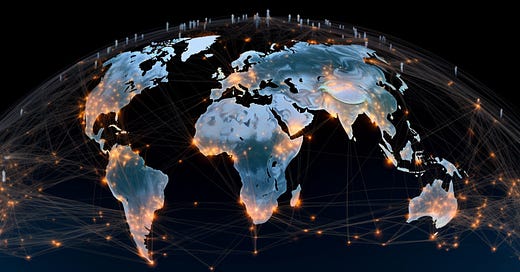Estimating the size of the internet is a complex task, as it is continuously growing and changing. However, we can provide rough estimates based on the data available up to 2021 and extrapolate from there.
Storage capacity of the internet
As of 2021, it was estimated that the world's total data storage capacity was around 33 zettabytes (33 trillion gigabytes), with the volume of data generated growing at an exponential rate. This number includes all data stored on servers, personal devices, and cloud storage systems. If we assume a consistent growth rate, the storage capacity of the internet in 2023 could be around 50 zettabytes or more.
Data transferred per second
In 2021, global internet traffic was estimated to be about 173,000 gigabytes per second (GBps). Given the increasing demands for bandwidth and higher-quality streaming services, we can assume that the data transferred per second has grown substantially since then. It's possible that the internet could be handling over 200,000 GBps in 2023.
Size of the 'clearnet'
The clearnet, or the surface web, is the portion of the internet that is indexed by search engines like Google, Bing, and Yahoo. It is estimated that the clearnet accounts for approximately 4-10% of the total internet. Considering the total storage capacity of the internet, the clearnet's storage capacity in 2023 might be around 2-5 zettabytes.
Size of the dark web
The dark web, which is not indexed by standard search engines and requires specific tools like the Tor browser to access, is a small part of the internet. Estimates from 2021 suggest that it accounts for less than 0.01% of the total internet, with its storage capacity possibly being around 50-100 petabytes (1 petabyte equals 1 million gigabytes). It's worth noting that the dark web's size could have changed since then, but it still remains a relatively small portion of the internet.
Number of devices and potential storage capacity
By 2021, there were approximately 10 billion connected devices worldwide, including smartphones, computers, IoT devices, and other smart devices. This number was projected to grow to around 25 billion by 2030. Assuming a steady growth rate, we can estimate there could be around 12-15 billion connected devices in 2023. The potential storage capacity of every device on the planet would depend on their individual storage capacities, which can vary greatly. However, considering the average storage capacity of devices and the growing trend of cloud-based storage solutions, we can estimate that the potential storage capacity of all connected devices in 2023 might be in the range of 5-10 zettabytes.
*It's important to note that these figures are rough estimates based on data available up to 2021 and certain assumptions about the growth of the internet. The actual size and capacities could be different, as the internet continues to evolve rapidly.
The human brain is a complex and intricate organ, and directly comparing it to digital storage and data transfer methods is not a perfect analogy. However, we can try to provide rough estimates based on available data and studies.
Storage capacity of the human brain
Estimates of the human brain's storage capacity vary, but a commonly cited figure is around 2.5 petabytes (2.5 million gigabytes) per brain. This number comes from comparing the brain's synapses (connections between neurons) to bits of information. Keep in mind that this is a rough estimate, and the human brain's storage capacity might be much more complex and harder to quantify accurately.
Considering the global population in 2021 was approximately 7.8 billion, the combined storage capacity of every human brain would be around 19,500 zettabytes (2.5 petabytes x 7.8 billion people).
Data transfer speed between humans
Data transfer speed between humans is challenging to quantify due to the differences in the way the brain processes and communicates information compared to digital systems. Human communication typically relies on speech, body language, and writing, and the speed of these communication methods can vary greatly.
One way to approximate data transfer speed in human communication is by considering the speed of spoken language. On average, people speak at a rate of about 150 words per minute. Assuming that each word contains about 10 bits of information (which is a rough estimate), the data transfer speed would be around 25 bits per second (bps) during verbal communication.
However, this estimation does not account for other forms of communication, such as non-verbal cues or the depth of meaning and context that can be conveyed in human interactions. Therefore, the actual data transfer speed between humans might be much more nuanced and harder to quantify.




